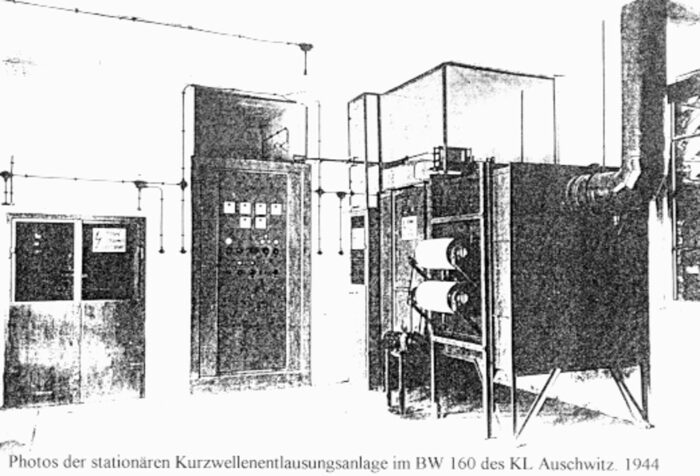Microwave Delousing
The 1936 Berlin Olympic Games were the first event in history which were transmitted live on TV. The powerful radio transmitters built for this had a frequency spectrum that was rather broad, so a minor amount of its energy was emitted in the frequency range now known as microwaves. When this transmitter was operated, it was found that insects present in the transmitter’s room had died. Further investigation revealed that radiation in the microwave spectrum quickly heats water to such a degree that living creatures exposed to it would quickly be burned or boiled to death. This included not only insects, but also microbes. Thus, it quickly became apparent that this could be a highly effective, efficient and rapid method not only for disinfestation (against vermin), but also for disinfection (against germs).
When the war broke out in 1939, the importance of pest control, particularly for soldiers at the front, was once more accentuated, since infectious diseases were the second greatest cause of casualties among German soldiers. Hence, the Siemens Company, which had manufactured the TV transmitters, set out to develop a microwave device to kill pests, with a primary focus on killing lice as the carriers of epidemic typhus. The aim was to overcome the long exposure times and frequent ineffectiveness of older methods, such as hot air or toxic gasses, and to find a way of killing not just the insects, their eggs and larvae, but also the dangerous microbes they carried.
Together with the Reich Biology Institute in Berlin-Dahlem, two subsidiaries of Siemens were involved in the development of the first microwave device the world has ever seen. When the device was demonstrated to civilian and military authorities at the beginning of the war, achieving not only a great throughput in a very short treatment time, but also absolute certainty in killing off lice, nits and microbes, the interest of the Reichsführung of the SS – Himmler’s office – was aroused. His personnel and material support greatly facilitated the further development of microwave devices.
Initially, these facilities were supposed to be used for front-line troops, for which purpose they were mounted onto a trailer. Ultimately, however, a stationary model was given preference. To operate the device, only a 380-Volt outlet or an electric generator with that output was needed, as well as some water to moisten the items to be treated (which were not allowed to contain any metal objects).

While the conservative Heer (army) was reluctant to order these new devices, the SS was very enthusiastic and ordered an initial five devices. After the first mobile version, which was deployed in Lublin, had demonstrated phenomenal efficiency and effectiveness in 1943, five more stationary devices were ordered.
The first camp to obtain a stationary microwave disinfestation device was Auschwitz. Its delivery had been promised for May 1943, hence the construction of some of the initially planned delousing facilities using other techniques was shelved. However, the delivery was repeatedly delayed due to problems with the development, not the least because the Siemens factories in Berlin had been bombed by Allied planes. As a result, epidemic control at the Auschwitz Camp was compromised, costing the lives of many inmates in 1943 and 1944.
The first microwave device, a mobile unit, was delivered and put into operation in early 1944 at the Birkenau Camp. A second, stationary device was installed in the reception building of the Auschwitz Main Camp a few months later and became operational in June 1944. Together with the first deliveries of the insecticide DDT to the Auschwitz Camp in April 1944, this revolutionarily effective new technology heralded the end of the need for Zyklon B and its associated fumigation gas chambers.
Adjusted for inflation, the stationary microwave delousing facility cost some two million U.S. dollars (value as of 2023). Interestingly, instead of utilizing this new technology at the eastern front to protect the lives of German soldiers, Germany’s wartime leaders decided to use it in Auschwitz to protect the lives of the inmates, most of whom were Jews. When it came to protecting lives threatened by infectious disease, the Germans gave priority to the Auschwitz prisoners. Since they were working in the Silesian war industries, their lives were evidently considered comparably important to the lives of German soldiers on the battlefield.
(For details, see Weber 1999; Rudolf 2024a, pp. 305-311.)

You need to be a registered user, logged into your account, and your comment must comply with our Acceptable Use Policy, for your comment to get published. (Click here to log in or register.)